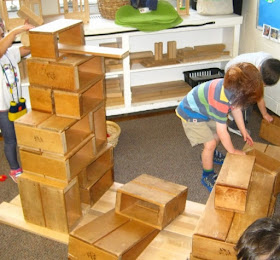Last week, Teacher Tom wrote a blog post titled “Eleven Things to Say Instead of Be Careful.” The blog was focused on the issue of “risky play”, better described by Teacher Tom as “challenging play” or “safety play”, and he suggested some more descriptive ways of explaining what we mean to children when teachers say, “Be careful.” His first example was “"That's a skinny branch. If it breaks you'll fall on the concrete."
What struck me about this statement isn’t just the
clarity and honesty of it, but that a teacher was giving a child an explanation
for why they should or shouldn’t do something. So often teachers tell children
to do something or not do something, without giving any reason. “Be careful”
falls in that category. So do so many other statements, sometimes given as a direction,
sometimes worded in a way that relieves the teacher of direct responsibility,
without actually giving the child the reason. “Chairs aren't for standing on.” “We wear hats when we go outside.” “The blocks can’t be higher than your head.”
All might be reasonable expectations for children, but wouldn’t they sound even
more reasonable if we explained to the children why we’re saying them?
“That chair isn't sturdy enough for you to stand on.”
“I’d like you to wear your hat to keep your head
warm.”
“I’m worried that if the blocks are that high, they
might fall on your head and hurt you.”
Of course, when we give the children a reason for what
we’re saying, we’re opening the door for them to present a counterargument, but
isn’t that part of learning how to interact with others in a democratic society?
Children need to understand that there are rules, but not that rules are
unilaterally imposed on other people without reason. When teachers revert to “it’s
the rule” or some version of “because I say so”, children might follow it, but
only because of the teacher’s authority, not because of an inherent sense that
it’s the right thing to do. If we want to teach children about morality,
decision making, and perspective taking, we need to model democracy in our own
speech. Rules don’t spontaneously exist, they’re created by people, and they
can be changed by people. Perhaps that’s why teachers are so hesitant to let
children into the process, because of a fear that even these very young people
will try to change the rules and take some authority away from the teacher. I
would argue that if the only way you can maintain authority is to remove
dissent, that authority isn’t valid, even over children. If we want our
children to grow up to understand fairness and reason, we need to include them
in the decision making process, even if it’s only by explaining our reasoning
to them.
And maybe some of our rules will need to be changed
after all.









